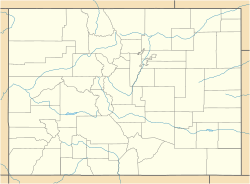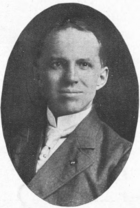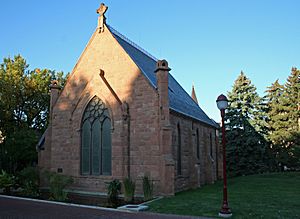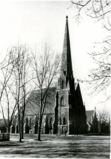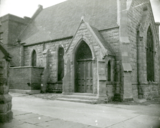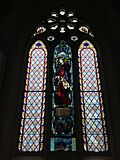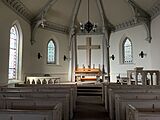Evans Memorial Chapel facts for kids
|
Evans Memorial Chapel
|
|

The chapel in 2022
|
|
| Location | University of Denver campus, Denver, Colorado |
|---|---|
| Area | 0.2 acres (0.081 ha) |
| Built | 1878 (moved 1959–1960) |
| Architectural style | Early Gothic Revival |
| NRHP reference No. | 74000567 |
Quick facts for kids Significant dates |
|
| Added to NRHP | December 27, 1974 |
| Designated NHL | 1988 |
The Evans Memorial Chapel (also called Evans Chapel) is an old and important chapel located on the campus of the University of Denver in Colorado. It is the oldest building in Denver that has been used for religious purposes without stopping.
The chapel was finished in 1878. It was built with money from John Evans. He wanted to honor his daughter, Josephine. John Evans was a governor of the Colorado Territory. He also helped start the Colorado Seminary, which is now the University of Denver.
The small chapel has a Gothic Revival style. It used to be part of Grace Church, a big Methodist Episcopal church in downtown Denver. In 1959, the chapel was moved to the University of Denver's campus. It opened again in April 1960. Today, it is the oldest building on campus. It is used by different religious groups and is a popular place for weddings.
Contents
History of Evans Chapel
John Evans was a former governor of the Territory of Colorado. He started two colleges for the Methodist Episcopal Church. One was Northwestern University, and the other was Colorado Seminary. Colorado Seminary later became the University of Denver.
In 1873, Evans gave money to build a new chapel. This chapel grew out of a Sunday school called "Evans Mission." It was part of the Lawrence Street Methodist Church in southern Denver. That same year, Evans also started collecting money from others to build this chapel. He wanted it to honor his daughter, Josephine, who had passed away in 1868 at age 24. Josephine had been married to Samuel Hitt Elbert, who was also a former territorial governor.
Building the Chapel
It took several years to collect enough money. The chapel cost $13,000 to build. It was finally finished in 1878. John Evans's friend, Matthew Simpson, who was a bishop from Pennsylvania, officially opened the Evans Memorial Chapel on October 10, 1878.
The chapel was located on West 13th and Bannock in Denver. This was near the original Trinity Church. It was one of five Methodist churches in downtown Denver. All these churches grew a lot before 1890. Many important leaders in Denver attended the chapel for their worship during this time.
Elizabeth Iliff was the wife of John Wesley Iliff. After her husband passed away in 1878, she used his money to start the Iliff School of Theology. This school became part of the University of Denver. Elizabeth later met Henry White Warren, an important Methodist Episcopal bishop. He was the first Methodist bishop to live in Colorado. Elizabeth was good at business, just like her first husband. She married Warren in the Evans Chapel on December 27, 1883.
Horato S. Hilton was the first pastor of the chapel. He also served as pastor of St. James. After two years, J. F. McClelland became pastor in 1880 and 1881. He had to leave because of poor health. David Hastings Moore, who was the chancellor of the University of Denver, then took over. During McClelland's time, only five people were listed as members of the chapel. John Evans's special seat at the chapel cost him $1,400 around 1880.
B. W. Baker was made a minister of the Evans Chapel in 1881. Moore was officially assigned to the chapel in 1883. In the 1800s, it was common for important ministers from other areas to serve in Colorado for a short time. One such minister was C. W. Buoy, who came to the Evans Memorial Chapel in 1882. Buoy was Bishop Simpson's son-in-law. He stayed for only two years and earned a salary of $6,300.
Henry A. Buchtel became the pastor of Evans Chapel in 1886. He later became the chancellor of the University of Denver and even the state governor of Colorado. Buchtel was very talented. His work at Evans Chapel soon earned him a more important job at the Lawrence Street Church.
Another minister, Gilbert De La Matyr, led the chapel's group in 1886. At that time, there were 183 members. When he left in 1889, the group had grown to 234 members. In January 1888, De La Matyr gave a sermon. He said that more space was needed for all the new members. After his sermon was printed in the Rocky Mountain News, a new, larger church was built. It cost $85,000 and was paid for by donations.
This larger building was finished in January 1889 with no debt. It was built next to the original chapel and was named Grace Church. The 1889 addition was made of red sandstone, like the chapel, but it was much bigger and had a tall spire. A large organ for Grace Church was bought for $10,000.
Christian Fichthorne Reisner became the pastor of the church by 1905 and served until 1911. Elmer Ellsworth Higley became a pastor in June 1910.
Grace Church once had 900 members. But by 1912, the number had dropped to 385. Bishop White Warren passed away that year, which led to many changes for the church. Charles O. Thibodeau tried to connect Grace Church with the changing community after he became pastor in 1915. George A. Lackland took over in 1918. With more community efforts, the church grew to 1,003 members by 1922. The church also helped start the Colorado Labor College. Later pastors could not keep up the growth. The church had 280 members in 1930. The Grace Community Center separated from the church in 1935.
The Grace Church Methodist group moved to the Denver neighborhood of University Hills after their last service in December 1953. The Evans Chapel and Grace Church were then sold to another religious group. This group worshipped at the original location from 1953 to 1958.
Moving the Chapel to a New Home
The University of Denver bought the old Grace Church property, which included the chapel, in 1958. The university had wanted to buy the property since 1947. They planned to tear down both church buildings to make parking for their law school.
Martin Rist, who was the President of the Rocky Mountain Methodist Historical Society, found out about these plans. He asked the university's chancellor, Chester M. Alter, to save the chapel. Alter liked the idea and wrote an article in the Rocky Mountain News titled "Let's Save the Chapel!"
Moving the chapel was paid for by a donation from John Evans. He was the former president of the university's board of trustees. He was also the grandson of the governor John Evans who first helped build the chapel. Other members of the Evans family also donated. The new spot for the chapel was west of Mary Reed Library. It lined up with Mount Blue Sky (which used to be called Mount Evans).
The Grace Church building, which was added in 1889, was too big to move. So, it was torn down. The original chapel was smaller, but it was still too big to move in one piece. It weighed 427 tons, which was too heavy for bridges. Even if power lines and traffic lights could be moved, it was still too difficult. A Denver traffic engineer said the chapel could not be moved. He joked, "We have enough trouble with chicken coops."
Instead, the chapel was carefully taken apart. Each piece was marked. Then, it was moved to the university's campus. This cost $80,000. It took four months to rebuild the chapel. On April 22, 1960, a special "Act of Thanksgiving" and re-dedication ceremony took place. Fourteen graduating students helped with the dedication. Sixty United Methodist Church bishops attended the event. The chapel was set up again as a "Protestant center on the campus."
The area around the moved Evans Memorial Chapel was turned into a garden. This cost $125,000. The money was given to the school in 1964 by Heber Harper. He had been the university's chancellor from 1922 to 1927. Parts of the Harper Memorial Garden, also known as the Humanities Gardens, used extra stone from the chapel's move and from the torn-down Grace Church.
When the university's larger Buchtel Chapel was destroyed by fire in 1983, the Evans Chapel took over many of its duties. The chapel was named a landmark by the City and County of Denver in 1969. It was added to the National Register of Historic Places in 1974. In 1988, it was named a National Historic Landmark. Today, it hosts Masses for Catholic university students and events for different Christian groups. In 2014, the chapel was reported to host an average of 53 weddings each year. Weddings in the Evans Chapel were paused for renovations but resumed in 2023.
Chapel Design and Features
The Evans Memorial Chapel is a fairly small building. Its outside is made of rough, red Colorado sandstone. The chapel's group quickly grew too big for the building. It was about 40 feet wide, 50 feet long, and 40 feet tall. It could seat 64 people and a 12-person choir. So, the larger Grace Church was built next to it.
The chapel is an example of early Gothic Revival architecture. Its look has been described as "like chapels in the west of France." The chapel has one main room. It runs from east to west and ends in an eight-sided apse on the west side. A choir area is below the east window. The main entrance is on the south wall, with a small entry room. The ceiling has fancy wooden beams with open patterns.
A survey in 1967 by the Colorado Historical Society said the building was in "excellent" condition. Some damaged parts had been replaced recently. One replaced part is a stone cross that came from the larger church that was torn down. A pipe organ was added in 1965.
The chapel's stained glass windows were moved with the rest of the building to the University of Denver's campus. Because they were old and had been poorly fixed before, some stained glass was taken out in 2022. It was restored with new paint and made stronger. Broken or missing pieces were replaced using parts from the company doing the work. This was the same company that helped move the stained glass in 1959. However, it was decided that any mismatched pieces would be kept. This was to show the chapel's unique history. Also, the lead used in the repairs is from the same 1880s time period as the original windows. The restoration of the windows was completed in 2023.
When the Evans Memorial Chapel was moved and rebuilt, people tried very hard to keep its original look and parts. But some changes were made then and over the years. For example, a stage was added and later removed before 1945. Also, damaged parts of the stone work were replaced.
Images for kids
See also
 In Spanish: Capilla Conmemorativa Evans para niños
In Spanish: Capilla Conmemorativa Evans para niños
- National Register of Historic Places listings in southeast Denver
- Chamberlin Observatory
- St. Vrain Church of the Brethren
- South Denver, Colorado, a Methodist community co-established by John Evans at the current site of chapel
- University, Denver


